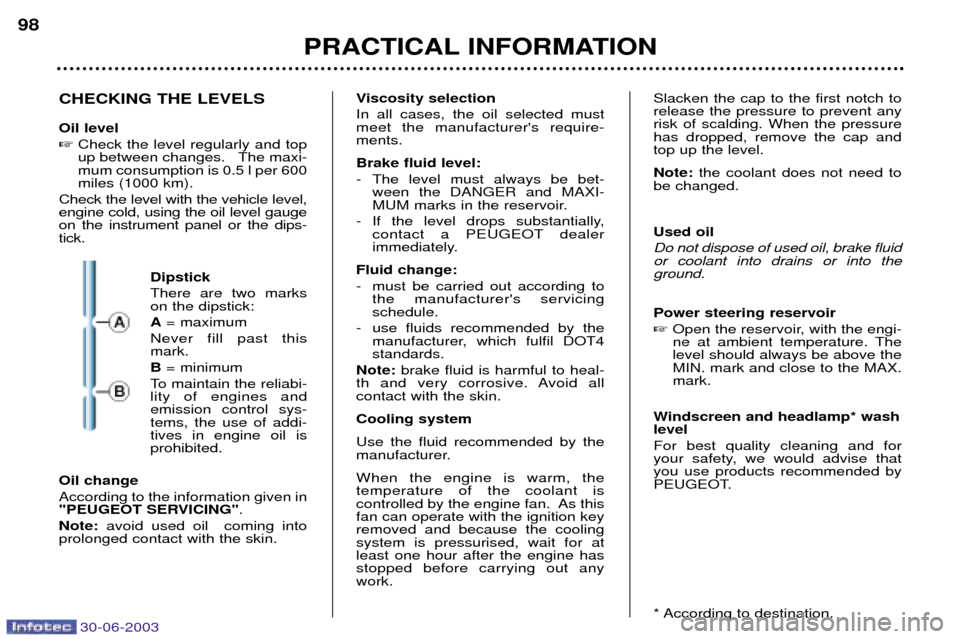Page 94 of 131

30-06-2003
YOUR 206 CC IN DETAIL93
FRONT AIR BAGS
These are folded in the centre of the steering wheel for the driver and in the
fascia for the front passenger. They are
deployed simultaneously, except incases where the passenger air bag isdisarmed.
Front air bag fault
If this warning light comeson, accompanied by anaudible signal and the mes-sage "Air bag fault" on the
multifunction display, con-
tact a PEUGEOT dealer to have thesystem checked.
AIR BAGS The air bags have been designed to maximise the safety of the occu-pants in the event of serious colli-
sions. They work in conjunctionwith the force-limiting seat belts. The electronic detectors register and analyse any abrupt decelera-tion of the vehicle: if the triggeringthreshold is reached, the air bagsinflate instantly and protect theoccupants of the vehicle. Immediately after the impact, the air bags deflate rapidly so that they donot hinder the visibility of the occu-pants nor their exit if necessary fromthe vehicle. The air bags are not deployed in the case of collisions which are not seri-
ous, for which the seat belt is suffi-cient to ensure maximum protection.The seriousness of a collisiondepends on the nature of the obsta-cle and the speed of the vehicle atthe moment of the collision. Air bags only operate when the ignition is switched on. Note:
the gas escaping from the air
bags can be a minor irritant. Disarming the passenger air bag*
To ensure the safety of your child, it is essential to disarm the pas-senger air bag when you install arear-facing child seat on the frontpassenger seat. �
With the ignition switched off, insert the key into the passengerair bag disarming switch 1, turn it
to the "OFF"position, then
remove the key keeping the slotin this position.
The air bag warning light onthe instrument panel is litthroughout the disarmingprocess.
* According to destination.
Page 95 of 131

30-06-2003
YOUR 206 CC IN DETAIL
94
In the
"OFF" position, the passen-
ger air bag will not be triggered in the event of an impact. As soon as the child seat is removed, turn the air bag slot to the"ON" position to re-activate the air
bag and thus ensure the safety ofyour passenger in the event of animpact. Operating check This is confirmed by an indicator light, accompanied by an audiblesignal and a message on the multi-
function display. With the ignition on (2nd notch), illumi- nation of this warning light accompa-nied by an audible signal and the mes-sage "Passenger air bag disarmed"
on the multifunction display, indicatesthat the passenger air bag is disarmed(switch in the "OFF"position SIDE AIRBAGS * These are incorporated into the frame of the front seat back, on thedoor side. They are deployed independently of each other depending on which sidethe collision occurs, in collisionswhich could cause injury to thechest, the abdomen or the head.
Operating check
This is confirmed by an indicatorlight on the instrument panel. It comes on for six seconds, each time the ignition is switched on. If the indicator light:
- does not light up when the ignition is switched on, or
- does not go out after six seconds, or
- flashes for five minutes then stays on,
contact a PEUGEOT dealer.
* According to destination.
Page 97 of 131

30-06-2003
YOUR 206 CC IN DETAIL
94
In the
"OFF" position, the passen-
ger air bag will not be triggered in the event of an impact. As soon as the child seat is removed, turn the air bag slot to the"ON" position to re-activate the air
bag and thus ensure the safety ofyour passenger in the event of animpact. Operating check This is confirmed by an indicator light, accompanied by an audiblesignal and a message on the multi-
function display. With the ignition on (2nd notch), illumi- nation of this warning light accompa-nied by an audible signal and the mes-sage "Passenger air bag disarmed"
on the multifunction display, indicatesthat the passenger air bag is disarmed(switch in the "OFF"position SIDE AIRBAGS * These are incorporated into the frame of the front seat back, on thedoor side. They are deployed independently of each other depending on which sidethe collision occurs, in collisionswhich could cause injury to thechest, the abdomen or the head.
Operating check
This is confirmed by an indicatorlight on the instrument panel. It comes on for six seconds, each time the ignition is switched on. If the indicator light:
- does not light up when the ignition is switched on, or
- does not go out after six seconds, or
- flashes for five minutes then stays on,
contact a PEUGEOT dealer.
* According to destination.
Page 101 of 131

30-06-2003
PRACTICAL INFORMATION
98
CHECKING THE LEVELS Oil level �
Check the level regularly and top
up between changes. The maxi-mum consumption is 0.5 l per 600miles (1000 km).
Check the level with the vehicle level,engine cold, using the oil level gaugeon the instrument panel or the dips-tick.
Dipstick There are two marks on the dipstick: A= maximum
Never fill past this mark. B = minimum
To maintain the reliabi- lity of engines andemission control sys-tems, the use of addi-tives in engine oil isprohibited.
Oil change According to the information given in
"PEUGEOT SERVICING" .
Note: avoid used oil coming into
prolonged contact with the skin. Viscosity selection In all cases, the oil selected must meet the manufacturer's require-ments. Brake fluid level:
- The level must always be bet-
ween the DANGER and MAXI-
MUM marks in the reservoir.
- If the level drops substantially, contact a PEUGEOT dealer
immediately.
Fluid change:
- must be carried out according to the manufacturer's servicing schedule.
- use fluids recommended by the manufacturer, which fulfil DOT4standards.
Note: brake fluid is harmful to heal-
th and very corrosive. Avoid allcontact with the skin. Cooling systemUse the fluid recommended by the
manufacturer. When the engine is warm, the temperature of the coolant is
controlled by the engine fan. As thisfan can operate with the ignition keyremoved and because the coolingsystem is pressurised, wait for atleast one hour after the engine hasstopped before carrying out anywork. Slacken the cap to the first notch torelease the pressure to prevent anyrisk of scalding. When the pressurehas dropped, remove the cap andtop up the level. Note:
the coolant does not need to
be changed. Used oil Do not dispose of used oil, brake fluid or coolant into drains or into theground. Power steering reservoir � Open the reservoir, with the engi-
ne at ambient temperature. Thelevel should always be above theMIN. mark and close to the MAX.mark.
Windscreen and headlamp* washlevel For best quality cleaning and for
your safety, we would advise thatyou use products recommended by
PEUGEOT.
* According to destination.
Page 111 of 131
30-06-2003
PRACTICAL INFORMATION
108
Fascia fuse box Unscrew the catch a quarter turn using a coin, then remove the coverto gain access to the fuses. The spare fuses and the pliers
Aare
secured on the inside of the fascia
fuse box cover. Removing and refitting a fuse
Before changing a fuse, the cause of the fault must be found and remedied. The fuse numbers are indicated on the fuse box. Use the pliers
A.
Always replace a faulty fuse (fault registered depending on fuse) with a fuse of the same rating.
Correct Incorrect
CHANGING A FUSE The fuse boxes are located under the instrument panel and in theengine compartment.
Pliers A
Page 112 of 131
30-06-2003
PRACTICAL INFORMATION
108
Fascia fuse box Unscrew the catch a quarter turn using a coin, then remove the coverto gain access to the fuses. The spare fuses and the pliers
Aare
secured on the inside of the fascia
fuse box cover. Removing and refitting a fuse
Before changing a fuse, the cause of the fault must be found and remedied. The fuse numbers are indicated on the fuse box. Use the pliers
A.
Always replace a faulty fuse (fault registered depending on fuse) with a fuse of the same rating.
Correct Incorrect
CHANGING A FUSE The fuse boxes are located under the instrument panel and in theengine compartment.
Pliers A
Page 113 of 131
30-06-2003
PRACTICAL INFORMATION109
Fuse Rating
Functions
1 15 A Heated seat - Alarm
4 20 A Mulltifunction screen - Navigation control unit - Boot lighting - Audio system - Retractable roof control unit
5 15 A Automatic gearbox diagnostics
6 10 A Coolant level - Automatic gearbox - Audio system - Steering wheel angle sensor (ESP)
7 15 A Driving school accessories - Alarm fitted as an accessory - Rain detector
9 30 A Hydraulic pump
10 40 A Driving mirror demisting 11 15 A Windscreen wiper
12 30 A Front windows
14 10 A Engine module - Air bags - Steering wheel stalk
15 15 A Instrument panel - Multifunction screen - Navigation control unit - Air conditioning - Audio system
16 30 A Locking/unlocking of doors
20 10 A Right-hand brake light
21 15 A Left-hand brake light - 3rd brake light
22 20 A Front courtesy light - Glove box lighting - Lighter
S1 Shunt PARC shunt